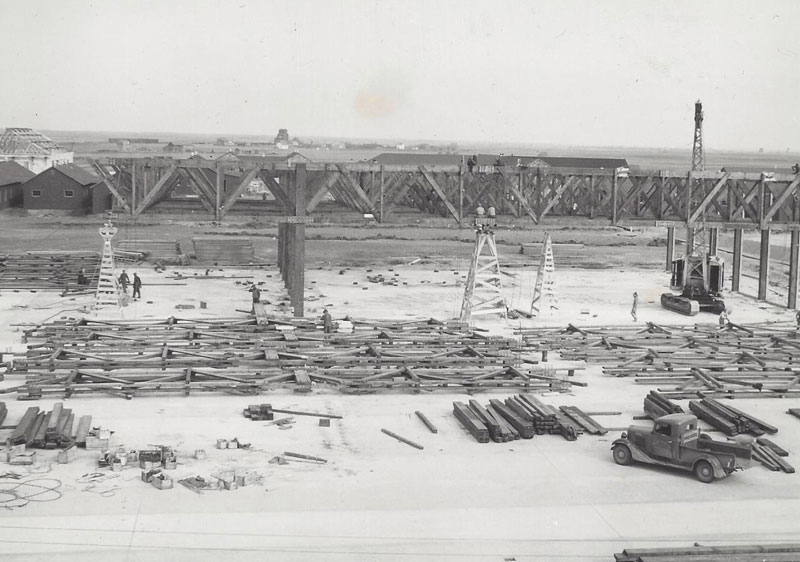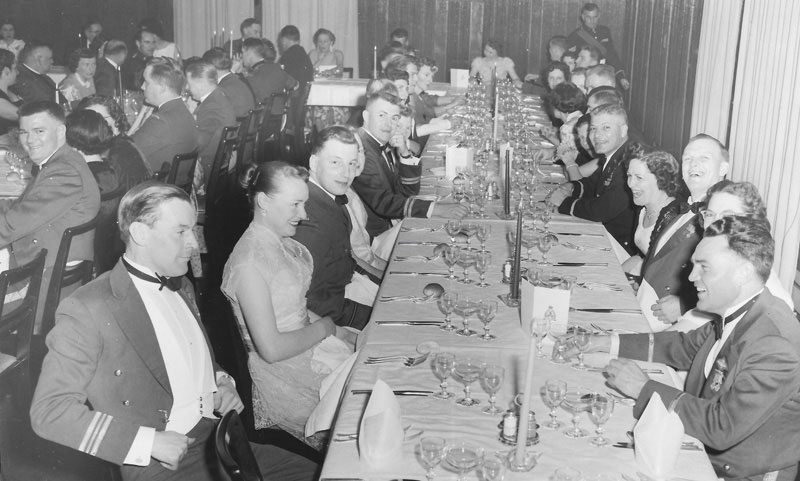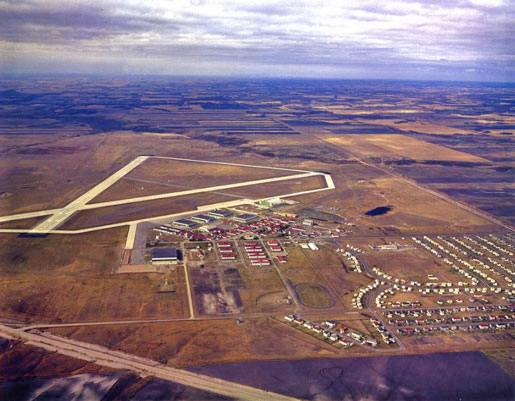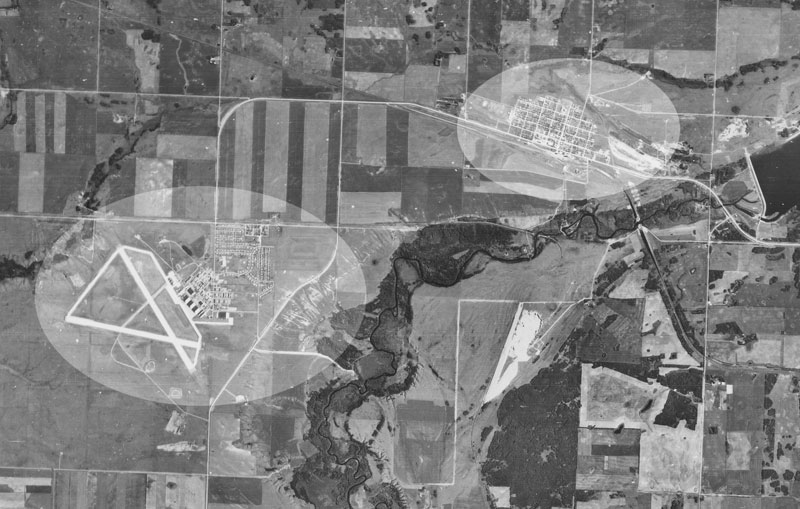

|

|
Part
2:
The Facility: A New Life for The Rivers Base

Base construction – a
huge project
with a wide-ranging economic and social impact.
Just as
Rivers was recovering from the Great Depression, the establishment of
the Air Force Base just outside of town changed everything.
Rivers was (is) a railway town and the direct trans-continental rail
link to ports in Eastern Canada was essential to its role as the site
of a vital wartime project. We were far from the front…but connected.
RCAF Station Rivers opened May 1942 when No. 1 Air Navigation School
re-located to Rivers from RCAF Station Trenton, becoming No. 1 Central
Navigation.
The British Commonwealth Air Training Plan saw 130,000 personnel from
Great Britain and the Commonwealth graduate from 107 training schools
across Canada. The impact of that decision was lasting and
transformative.
People from all over the Commonwealth were transplanted into the
municipality. The economic spin-offs were enormous. The very identity
of the town was shaped by the proximity of the thousands of young men.
Relationships were built, many of which lasted long after the war was
over.
As the war progressed, Rivers also became a training centre for Army
pilots, parachutists and flying instructors from the Army, RCN and
RCAF. Additionally, the Royal Canadian Corps of Signals and the Air
Dispatch School made Rivers their home.
By the time No. 1 CNS disbanded in August 1945, a combined total of
11406 Commonwealth navigators had been trained here.
RCAF
Station Rivers – A Peacetime Role
The
wartime training that took place here was a huge contribution to the
Allied war effort and the people of Rivers were (and are) justifiably
were proud to be part of it. That alone would have shaped the nature of
the town of Rivers for decades to come.
But the real long-term impact was assured when RCAF Station Rivers
remained open after the war, becoming part of the post-war RCAF. For
the next two decades it served a variety of training functions, all
vital to the purpose of a Peacetime Armed Forces in a Cold War world.
The Army Aviation Tactical Training School provided pilot training to
Army aviators, as well as helicopter instructor training for the Army,
RCN and RCAF. No. 6 Signal Regiment, Royal Canadian Corps of Signals
and the Air Support Signals Unit provided communications duties at
Rivers.
The Canadian Parachute Training Centre, established at Camp Shilo in
1942, merged with the Airborne School of the Canadian Joint Air
Training Centre and relocated to RCAF Station Rivers, making the
station Canada's main para-training centre.
Aside from the importance of these various training missions to our
national security, there were countless benefits to the local
community. In 1948, the Joint Air Photo Interpretation School
opened at RCAF Station Rivers. While the analysis of aerial photographs
certainly had vital civil defense purposes, locally we were left with a
series of vivid aerial photos of local towns and sites that help us
continue to interpret our regional history. In some cases they are the
only existing visual reminders available.
People in Rivers today still remember seeing movies at the Base
Theatre, playing volleyball in the excellent gym, swimming in the pool
and attending dances and social events.

The base became a
social centre for the community.
The people of Rivers were able to
use the extensive modern facilities.
In 1956, with the Royal Canadian Navy having recently acquired its
first fighter jet, the F2H3 Banshee, pilots from VF 870 and VF 871
Squadrons were also sent to Rivers for training. These and other
functions came and went over the years As a result of the Unification;
RCAF Station Rivers was re-named CFB Rivers.
The End of an Era
In much the same way as events conspired to create a
situation whereby the timing was right to establish a Bicycle Factory
in rural Manitoba, a series of events seemed to work together to close
CFB Rivers.
In a way it came down to cost cutting and politics. The nature of armed
forces is always changing. The nature of defense needs changes with
changes in technology and the international situation. As the memory of
World War 2 faded and the geopolitical makeup of the work changed, new
priorities emerged.
An earlier example was the story of the Avro Arrow, an advanced fighter
jet developed in Canada, then scrapped after a huge expense. Why? Our
American neighbours were already changing the focus of nuclear defense
by focusing on missiles rather than planes. Canada felt pressure to do
the same. The next war would be much different from the last one.
The Federal Government had already amalgamated Canada’s Armed Forces,
and the next step was “rationalizing” military installations. In other
words, the feeling was that there were too many Forces bases and we
could do without a few. CFB Rivers was declared surplus to defense
needs and as a result, the station closed in September 1971.
A New Life
In September 1972, the land was turned over to the
Department of Indian Affairs and Northern Development for use as an
industrial training centre for Manitoba First Nations, the
Oo-Za-We-Kwun Centre.
The Centre was designed to be a unique and innovative experiment to
improve the well-being of Canada's poorest demographic group.
The Air Force base provided a 2,500-acre site and the Centre had a
maximum population of 3,000 people. It included an industrial park with
four industries, a day care centre, a school, a recreation program and
counseling services.
The concept was first developed by Frank E. Price (1931-2015) in the
proposal, Rivers Training Centre: A Social Change Program for Indian
People. The identified needs of First Nations people included lack of
training and saleable skills, and the inability to relate to an urban
environment.
The stated purpose of the Oo-za-we-kwun Centre was to "provide
technical training facilities to Indians so they may find better
employment". Its objective was to provide "Canadian Natives with
training, employment and a future ... bringing together different
cultures into a closely-knit community environment."
Today we might reject the plan as being based upon some cultural
presumptions, but in 1972 it was well-intentioned and had the support
of the Manitoba Indian Brotherhood.
According to its own publicity, the Centre was "designed to help Native
People participate more effectively in a modern Canadian environment.
The residential family program includes a five-week Life Skills course
followed by a two-year transfer of learning period during which
counseling, paid employment, and community activities are available."
The Centre was named after Oo-za-we-kwun (O-zah-wah-sko-gwan-na-be or
Yellow Quill), c1840-1910, chief of the then Portage Band of the Plains
Ojibway. He was signatory of the 1871 Treaty One between Canada and the
First Nations.
The Oo-za-we-kwun Centre was initially funded by the federal government
department of Indigenous and Northern Affairs Canada, the Manitoba
Government and the Manitoba Indian Brotherhood although the latter two
pulled out during the life of the Centre.
Initially deemed a success, the Centre attracted some notable clients.
Edson Industries, a truck camper and trailer manufacturer moved from
Neepawa, Manitoba, to benefit from the subsidies provided. It employed
80 people but went bankrupt in 1983.
Arnold Manufacturing produced vinyl furniture, which then evolved into
fiberglass seating, as it was sturdy and vandal-proof, for restaurants
such as McDonalds. After closure, they moved to Windsor, Ontario. The
company was involuntarily dissolved in 1988.
Tim-Br-Fab Industries produced pre-fabricated home packages. They were
sold across Western Canada. The company survived. It is now located in
Oak Bluff, Manitoba. It retains essentially the same business model.
Over 10,000 people took part in the Oo-za-we-kwun program. A number of
important Canadian Indigenous leaders worked or trained there:
Ernie Daniels, chief of Long Plain First Nation (1978-1984) and
Vice-chief of the Assembly of First Nations
Eli Taylor, chief of Sioux Valley Dakota Nation, elder.
Alan Pratt, elder, Sioux Valley Dakota Nation.
Norman Fleury, professor Brandon University, elder, Metis National
Council.
Margaret Smith Lavallée, Elder in Residence, University of Manitoba.
Jules Lavallée, Elder in Residence, Red River College.
Violet Daniels, elder, Peguis First Nation
John Hicks, Churchill, Manitoba, Chairperson, Atuqtuarvik Corporation
Ken Courchene Jr., Chief, Sagkeeng First Nation.
There is an active "alumni", composed largely of children who were
brought up at the Centre.
The Centre was closed in 1980 when the then Department of Indian
Affairs removed its funding. The land had some continued military use
until 1982 when Federal Government then offered the base for sale to
the public.

The
self-contained site, with spacious industrial buildings and adjacent
residential complex was ideal for a manufacuring venture.

The proximity to Rivers, and its transcontinental railway line was also
advantageous.

|
|